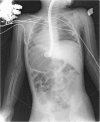Button battery removed from the stomach resulting in a missed aortoesophageal fistula - a multidisciplinary approach to rescuing a very young patient: a case report
- PMID: 30333066
- PMCID: PMC6193310
- DOI: 10.1186/s13256-018-1818-5
Button battery removed from the stomach resulting in a missed aortoesophageal fistula - a multidisciplinary approach to rescuing a very young patient: a case report
Abstract
Background: While coins are still the most common foreign bodies swallowed by children, ingestion of batteries has become more frequent among children due to the increasing access to electronic toys and devices. Coin battery ingestion is potentially life threatening for children. Aortoesophageal fistula is the most common cause of death in children who have swallowed coin batteries, and there have not been any reported survivors.
Case presentation: A 3-year-old Caucasian girl presented to the emergency room of a community hospital complaining of abdominal pain. An abdominal X-ray showed a coin lithium battery located in the fundus of her stomach, and she was transferred to a referral pediatric hospital. In the following hours she developed massive hematemesis and severe hypovolemic shock. An emergency laparotomy was attempted, and the coin battery was removed. The initial surgery and multiple blood transfusions did not, however, improve the clinical situation. She was then referred to our tertiary referral center, where a multidisciplinary team decided to attempt a combined angiographic and endoscopic approach to resolve a life-threatening aortoesophageal fistula. A 3-year follow-up was uneventful.
Conclusions: Coin batteries are designed for a wide variety of small appliances, such as hearing aids, watches, remote controls, and toys. Although a change in the clinical approach to battery ingestion is needed to avoid misdiagnosis or delayed treatment, primary prevention of battery ingestion would be even more effective than an improved treatment.
Keywords: Aortic rupture; Balloon-expandable stents; Bleeding; Hemostasis; Thoracic endovascular aortic repair; Urgent procedure.
Conflict of interest statement
Ethics approval and consent to participate
Authors are reporting for the first time, a successful emergency combined angiographic and endoscopic approach to resolving a life-threatening aortoesophageal fistula after ingestion of a lithium-cell coin-battery. The procedure was performed as rescue therapy in an emergency medical condition.
Consent for publication
Written informed consent was obtained from the patient’s legal guardians for publication of this case report and any accompanying images. A copy of the written consent is available for review by the Editor-in-Chief of this journal.
Competing interests
The authors declare that they have no competing interests.
Publisher’s Note
Springer Nature remains neutral with regard to jurisdictional claims in published maps and institutional affiliations.
Figures




References
Publication types
MeSH terms
LinkOut - more resources
Full Text Sources
Medical

